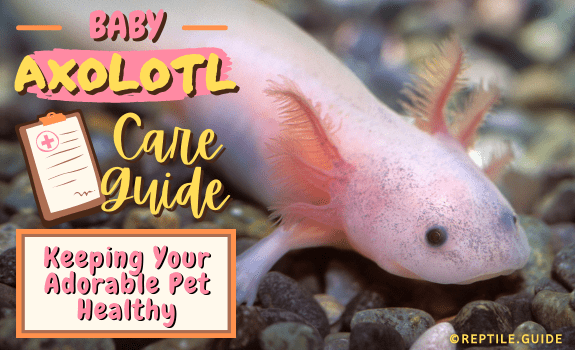When deciding to get these animals, most people buy a baby or juvenile axolotl as a pet.
This article covers the background information about these animals and how to take care of their babies.
In This Article
What is an Axolotl?
Most amphibians undergo major changes as they move toward adulthood.
Frogs and toads start as tadpoles, while salamanders and newts begin life in a larval stage before taking on their adult form.
The axolotl, or Mexican walking fish, scientific name Ambystoma mexicanum, is different in that it’s neotenic.
Neotenic refers to the keeping of juvenile characteristics into adulthood.
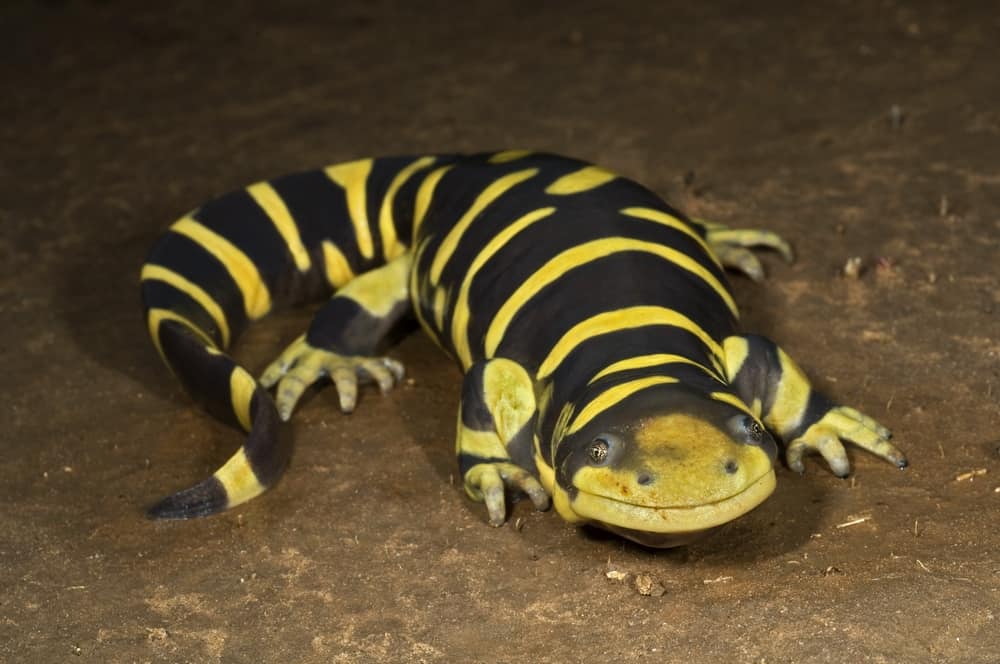
Sometimes called Mexican walking fish or Mexican salamander, axolotls are descendants of tiger salamanders who keep their larval form for their entire lives.
Completely aquatic, these aquatic creatures keep their external gills, even though they develop lungs. They never venture onto land.
The Story of the Mexican Walking Fish
These neotenic salamanders are critically endangered in the wild; yet, it’s very common in captivity.
This is because researchers consider them to be valuable research subjects due to their unbelievable regenerative abilities. Because of this, this species has been widely bred.
Almost everything that we know about the axolotl comes from captive specimens.
Your baby axolotl is an ambassador to a wild species that’s on the verge of extinction while at the same time making a major contribution to medical science.
History of the Axolotl
The Mexican walking fish played an important role in the culture of the Aztecs.
The axolotl received its name from the Aztecs, who considered it the embodiment of the Aztec god known as Xolotl.
The Aztecs and Axolotls shared a common home, which was Lake Xochimilco.
Lake Xochimilco, and some of the surrounding lakes, are the only place where you can find wild axolotls.
In 1863, French explorers caught 34 axolotls and sent them to the National History Museum in Paris.
Six of those axolotls made their way to Auguste Duméril, a French zoologist.
Duméril successfully bred them, and he became a supplier of them to scientific institutions throughout Europe.
All captive axolotls originate from Duméril’s original breeding stock.
Where are Axolotls Found?
The entire wild population lives in Mexico’s Xochimilco-Chalco basin, which consists of several native lakes.
This area was once filled with lagoons, marshes, and swamps. However, human encroachment poses a threat to this habitat.
Critically Threatened But Common
The axolotl is truly a contradiction among critically endangered species.
Wild populations are seriously threatened; yet, they’re common in captivity and enjoy worldwide popularity.
Some breeders specialize in axolotls. They produce morphs and sell them to the pet trade.
The axolotl is a favorite among medical researchers due to its impressive ability to regenerate its body parts.
In Japan, they breed axolotls for the food industry and use them as fried snacks.
However, the wild population is anything but common. The canals of Xochimilco, near Mexico City, are the only place where you can find wild axolotls.
This species is seriously threatened due to pollution and the loss of natural habitat.
The loss of habitat is not a recent thing, as it started with the rise of the Aztec Empire. The expansion of the empire encroached on this salamander’s habitat.
In 1998, the National Autonomous University of Mexico surveyed the size of the wild population in Mexico City.
They estimated that there were 6,000 axolotls per square kilometer. In 2015, it was 35 animals per square kilometer.
Because of their popularity as pets, the Convention on International Trade in Endangered Species (CITES) lists axolotls in Appendix 2.
Appendix 2 indicates that the axolotl is currently not facing extinction but could be unless authorities implement trade controls.
Because of this, you can’t remove axolotls from the wild.
Breeding programs, such as the one undertaken by the University of Kentucky have bred hundreds of generations of captive-bred axolotls.
Axolotl Behavior
We know little about this amphibian’s behavior in the wild, beyond that they’re nocturnal.
They spend the day burrowed in mud or water plants to avoid detection from predators. At night, they hunt for prey.
Though they have gills, they’ll sometimes come to the surface to get a gulp of air.
Axolotls’ Physical Appearance
Upon reaching adulthood, axolotls average 9 inches in length. We consider axolotls young adults when they’re between 2.5-4 inches in size.
Axolotls have long tails and a dorsal fin that runs the length of their body.
Large feathery gills extend from the back of their heads, which sway in the water.
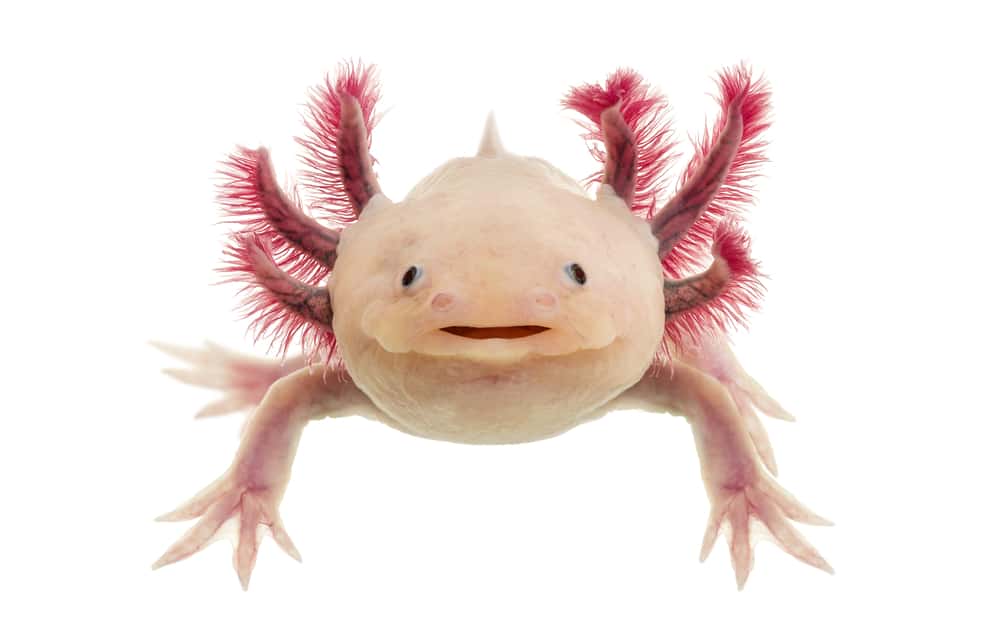
Their round eyes are dark and have a yellow-colored iridescent iris. Also, they lack moveable eyelids.
Its limbs are lizard-like and it uses them to move along the bottom of lakes.
Wild axolotls can take on a range of colors, including brown, green, and black. Some specimens have speckles of gold.
Today, the color of all captive axolotls is due to selective breeding. There are also a variety of morphs, which we’ll discuss later.
How Long Do Axolotls Live?
If properly cared for, axolotls can live for up to 15 years.
As with most information about these animals, we have no record of their life expectancy in the wild.
Are Axolotl Good Pets?
Axolotls make great beginners pets if you have experience maintaining a freshwater aquarium or keeping aquatic reptiles.
If you don’t have this kind of experience, it would be better to leave them to intermediate reptile keepers as they require special care to meet their water quality needs.
With the right knowledge, your axolotl pet will be easy to care for, and they’re both hardy and engaging.
The axolotl is a display animal, and you shouldn’t handle it. Furthermore, they stress easily.
Axolotls and the Law
Before getting an axolotl, it’s important to determine the laws in your area regarding the selling of axolotls.
Knowing your local laws is especially important if you plan to buy your axolotls from a breeder in another region or state.
The following states have laws that either limit or restrict the sale of axolotls:
- New Jersey
- Maine
- California
- Virginia
Some states, like New Mexico, allow keeping axolotls. However, you can’t import them from outside of the state.
Also, some local statues may have their own restrictions.
Where to get Axolotls
As stated earlier, most axolotls available for purchase will be young ones.
We recommend buying axolotls from a reputable breeder, though you can also find them at reptile expos.
A reputable breeder will give you documentation on the animal’s health history, and how they’re being kept in respect to water quality (which we’ll discuss later).
Another reason you want to deal with a professional is that there are cases where the customer receive tiger salamander larvae instead of axolotls.
When they’re young, the larvae of both species look very similar.
The price for axolotls ranges from $20 to $70, with some morphs costing more. This is especially true with the more unusual colors, like copper.
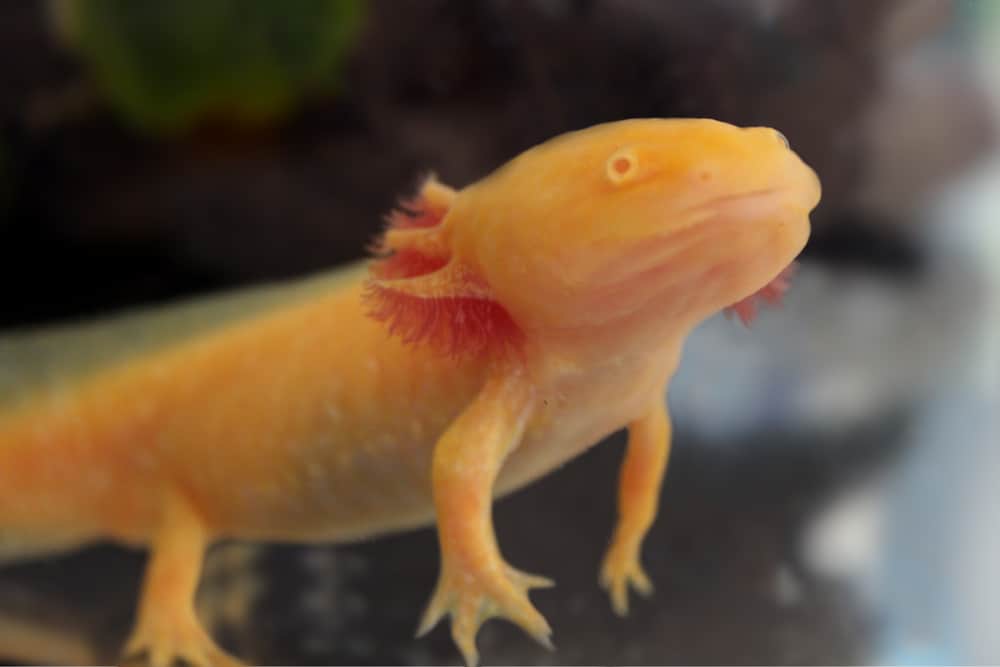
Expert Fact: While morphs of axolotls show their colors at a young age, tiger salamander larvae come in their natural colors.
How to Select a Healthy Axolotl
When selecting an axolotl, you want to look out for signs that show that it’s healthy. These include:
- It’s active.
- Its body is plump.
- The skin is smooth and not flaky.
- The axolotl can lift its body off the ground and move around easily.
One other thing to look out for is the tail.
When the axolotl has a curled tail, that’s a red flag. A curled tail may be a sign of stress.
Another concern is an axolotl that appears to have trouble staying on the ground or that tends to float.
Excessive floating may be a sign that it has an air bubble in its digestive tract.
Caring for Baby Axolotls
The following care guide provides information on how to care for your baby axolotl.
Selecting a Tank for Your Baby Axolotl
While you can keep adult axolotls in a 10-gallon fish tank, the ideal axolotl tank should be 15-20 gallons big.
If you can keep an adult axolotl can in a 10-gallon fish tank, it would make sense that you can keep baby axolotls in an even smaller tank. However, we don’t recommend it.
Baby axolotls are prone to cannibalism or leaving their siblings with missing limbs. It’s advisable to keep young axolotls separate from each other.
If you decide to keep more than one axolotl in the same space, a large tank will help them avoid each other.
Another reason why you should give your young axolotl ample space is that it’s easier to maintain water quality for a larger tank than with a small one.
The advantage of getting a 20-gallon tank is that it will provide plenty of room for when your axolotl grows up.
Also, the increased tank size will make maintaining the water quality easier than a smaller tank.
Housing Setup for Your Young Axolotl
Axolotls are completely aquatic, so there’s no need to provide them with a basking site. However, there are other features that you’ll want to include in the tank:
Lighting Requirements
Axolotls don’t require any special lighting. If you provide any lighting, it should be dim lighting.
Axolotls avoid light, so it’s a good idea to offer them dark places to hide.
Also, they’re sensitive to UV-B radiation
Lid
Though axolotls will not leave the water, they often jump. A lid will prevent them from jumping out and keep foreign bodies out of the axolotl tank.
Substrate
There’s no consensus when it comes to using substrate in the bottom of the tank.
Some believe that providing a substrate makes axolotls feel more secure, while others think substrates are unnecessary.
Not having substrate makes it easier to clean the axolotl tank.
If you provide substrate, we recommend using a bigger substrate than your axolotl’s head (i.e. large river stones).
Axolotls can swallow substrate when eating, which can lead to impactions in the digestive system.
However, you can safely use fine sand as a substrate as it’s small enough not to cause problems.
Hides
Axolotls, especially young ones, may avoid direct light. Also, as previously mentioned, youngsters are cannibalistic.
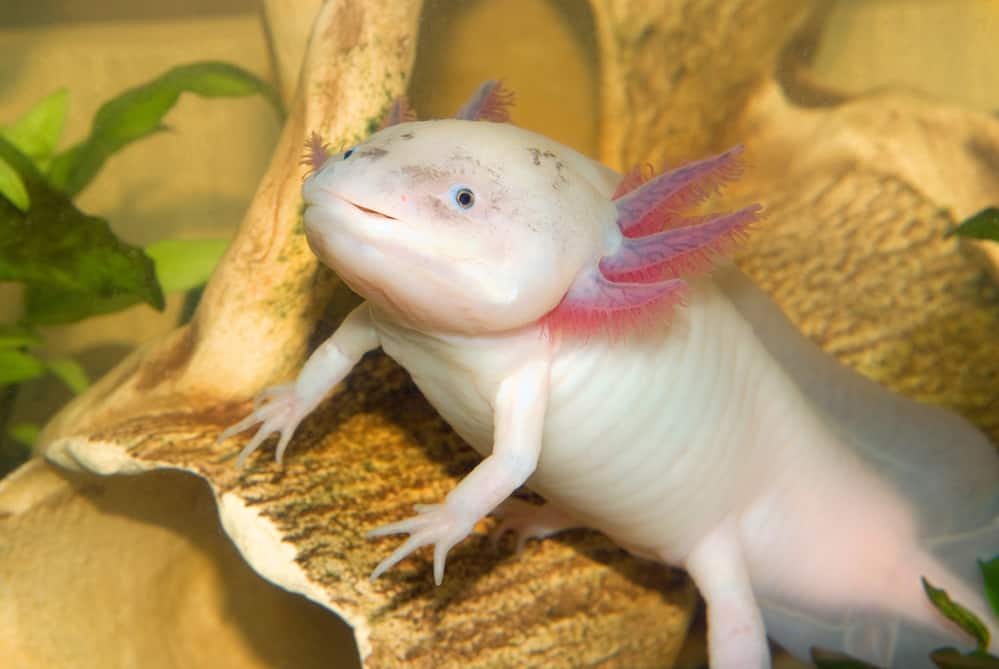
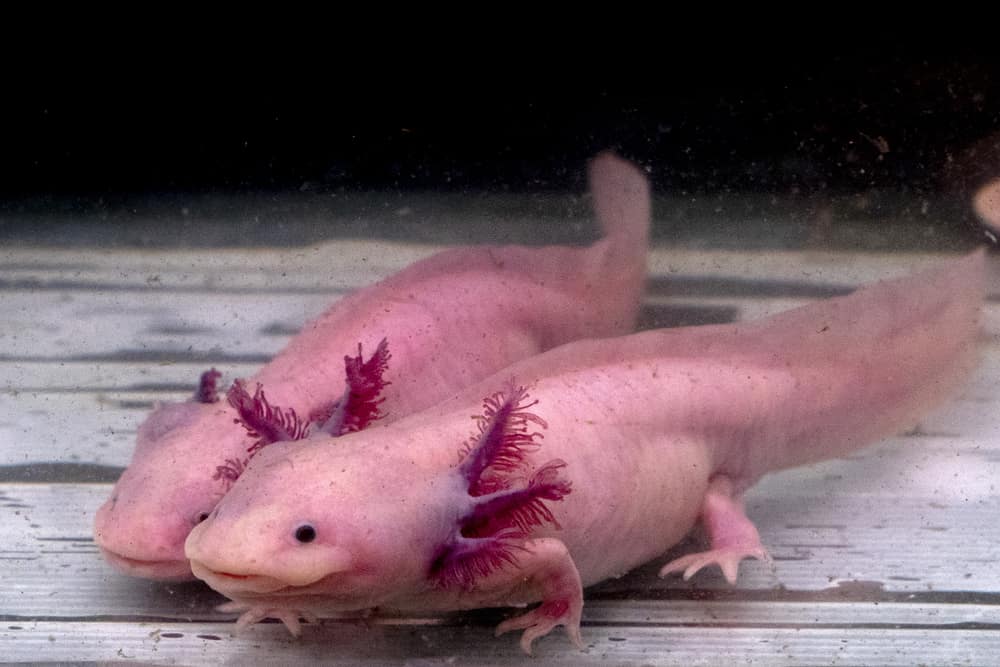
Providing your axolotl with a hide will offer it a place to take refuge from both the light and its siblings.
Hides can be in the form of caves or sections of pipes.
Plants
We don’t recommend using live plants in the tank.
Live plants need light, and axolotls are very sensitive to UV-b radiation. Using artificial plants would be a better choice.
Expert Tip: Keep the tank out of direct sunlight. Axolotls normally avoid bright light, and sunlight can raise the water temperature (see the Temperature section).
Water Quality and Temperature for Baby Axolotls
The most difficult part of keeping axolotls is providing and maintaining good water quality.
If you have experience keeping freshwater fish, then none of the information in this section should be new to you.
If you don’t have prior aquarium experience, understanding this information is essential before purchasing an axolotl.
Filtration
One of the main causes of death in axolotls is inadequate water quality.
Using an aquarium filter is a good way of maintaining the proper water quality.
When using an aquarium filter, it’s important to keep the water flow at a minimum.
Filters that produce fast-moving water can create stress in axolotls.
You need a balance, where the filter can adequately clean the water while at the same time not stressing out the axolotls.
One way to reduce the outflow of the filter is through the use of plastic plants.
Treating the Water
You need to treat the water used in the tank so that it’s safe for your axolotl.
Tap water contains chlorine and chloramines that are dangerous to axolotls.
You can buy water conditioner from an aquarium shop. The conditioner will remove these elements from the water.
Expert Tip: Never use distilled water in the aquarium.
PH
Axolotls prefer a water pH level of between 6.6 and 7.5.
You can buy a pH kit at most aquarium stores. It’s essential for checking the tank’s water chemistry.
Temperature
The ideal range of water temperature for the axolotl is between 60 and 64 degrees Fahrenheit (16-18 degrees C).
Because of this, an aquarium heater is not needed in most places.
The water temperature should never go over 75 degrees as this can be fatal.
Tank Cycling
So, you’ve reached the stage where your axolotl tank is all set up.
Congratulations! However, you still need to do one more step before introducing your axolotl to its new home.
When the tank is all set up, you need to cycle the tank.
Letting the tank cycle entails allowing the tank to sit for two weeks so that the water conditions can settle and the bacteria in the filter establish themselves.
As the tank cycles, continue to check the pH of the water.
Water Changes
If you don’t have a filter in the tank, you’ll need to do water changes.
Water changes involve removing 20% of the water from the tank.
Water changes help prevent the buildup of nitrates in the water.
Treat the water used to replace the old water with a water conditioner. Ensure that it’s of the same temperature as the water in the tank.
When siphoning water from the tank, do it from the bottom of the tank.
You should do water changes daily. If you have a filter, water changes can benefit your pet, though you can do them less frequently.
Do Axolotls Need Brackish Water?
Some axolotls come from brackish water in the wild, depending on which lake they were born in.
Brackish water is water that has a salinity that’s less than ocean water but more than freshwater.
The best way to determine if your pet requires brackish water is to contact the breeder or dealer and ask how they kept your pet.
If you want to create a brackish water environment for your pet, add one teaspoon of aquarium salt (also known as marine salt) for every 10 gallons of water.
Expert Tip: Use only pure sea salt. Don’t use salt that contains iodine.
Feeding Your Baby or Young Axolotl Pet
In their natural habitat, axolotls were the top predator until invasive species were introduced.
Their prey includes worms, insect larvae, mollusks, crustaceans, and small fish.
In captivity, you can feed axolotls:
- Earthworms
- Bloodworms
- Brine shrimp
- Frozen pellets
- Tubifex Worms
- Frozen fish food
- Commercial fish pellets
- Small steps of liver or beef
Expert Tip: In captivity, young axolotls grow faster when fed a diet on bloodworms.
When feeding live foods, don’t feed wild-caught food as they may have parasites.
When feeding axolotls, you can use round nose forceps and dangle the food in front of your pet. You can also just drop the food in front of them.
Frozen food and pellet food make feeding convenient.
In general, no vitamin or mineral supplements are necessary.
Remove any uneaten food the same day to avoid polluting the water.
Feed a baby or young axolotl daily. The portion size should be equivalent to four small worms.
As your pet matures, you can feed it every other day. Axolotls will stop eating when they’re full.
You can also check out our axolotl diet guide to find out more!
Axolotl Tank Mates
It’s best to keep axolotls alone unless you’re breeding them. As mentioned before, baby axolotls are cannibalistic.
Though this tendency becomes less with age, even adult axolotls may eat a smaller tank mate.
Axolotls will eat tank mates that belong to other species, such as fish. In turn, fish will nibble the gills of axolotls.
While some people successfully keep more than one axolotl in the same tank, we don’t recommend it.
Health Issues
While axolotls are hardy in captivity, they’re susceptible to a range of health issues. The following are the most common:
- Hyperthermia: As noted before, the ideal water temperature for your pet is between 60 and 64 degrees.
Temperatures higher than that can cause problems for them.
At 75 degrees, axolotls may stop eating or become too buoyant.
Higher temperatures can also lead to bacterial infections.
- Obstructions: Axolotls may ingest foreign bodies that can lead to obstructions, which can be fatal.
It’s for this reason that it’s important to consider the substrate that you use.
Symptoms of obstructions include sluggishness and a loss of appetite.
- Overfeeding: Overfeeding your axolotl can lead to obesity.
- Exophthalmia: Also known as “bulging eyes,” it results from long-term exposure to elevated nitrate levels.
- Skin infections: Skin issues can be bacterial or fungal infections and are usually caused by not maintaining the water quality.
- Ammonia buildup: The waste products of your pet produce ammonia.
When allowed to build up, it can cause viral or bacterial infections.
Ammonia buildup can also cause respiratory problems and damage your pet’s gills.
Other symptoms include your pet’s “gulping” and inflammation.
- Injuries from sharp objects: Axolotls lack protective scales, and they have delicate gills.
Your axolotl can easily injure itself on sharp objects so remove any objects from the aquarium that may harm it.
- Air in the abdomen: A condition that young specimens are particularly susceptible to is taking air into their abdomens.
Symptoms of air in the abdomen include a distended abdomen and floating upside down.
This ailment results from the immature digestive system of the axolotl having to acclimate to a high protein diet.
As the axolotl matures, this condition will correct itself. You can get more immediate results by reducing the portion size that you feed your pet.
- Skin disorders: The most common skin disorders are blisters and lesions caused by bad water quality.
It’s highly recommended that you buy a water quality test kit and test your water regularly with any aquatic animal.
They’re also susceptible to external skin parasites, which are easily diagnosed by microscopic examination of the skin.
As with other skin issues, skin parasites are often secondary to poor water quality.
- Ambystoma Tigrinum Virus (ATV): A virus that creates skin blisters. This virus can be fatal to axolotls.
As this virus is contagious, you need to take precautions to protect other animals.
As there’s no treatment for this disease, the most humane thing to do is euthanize the axolotl.
You need to disinfect the tank and any supplies or tank furnishings.
We recommend seeking veterinary advice if your axolotl is experiencing health issues.
Axolotl Morphs
As with ball pythons and other reptiles, breeders have selectively bred axolotls to create morphs.
Breeders have produced these axolotls in a variety of colors and patterns. The following are some of the available morphs:
- Leucistic: This morph is all white with red gills. However, it’s not an albino as it has dark eyes. It’s one of the most popular morphs.
Leucistic animals, while all white, have black eyes. True albino animals have red eyes.
- White Albino: Unlike the leucistic, the albino is all white and has red eyes. It also has red gills.
- Golden Albino: Unlike the white albino, this morph has a golden body. Its gills are peach-colored.
- Melanoid: This resembles wild axolotls, except they’re darker in color and lack gold flakes that cover other forms.
Both wild and melanoid axolotls are dark in color and are similar looking.
Rarer morphs include:
- GFP: This morph glows when exposed to UV light. Scientists produced this morph for use in research, but it eventually found its way into the pet trade.
- Cooper: This variation of the albino axolotl is one of the rarest of the morphs. Their coloration is light brown with freckles, and they have red eyes.
If you want an odd and engaging pet and know something about keeping a freshwater aquarium, the axolotls make great pets.
We hope you’ve enjoyed this article about caring for baby axolotls. When caring for adult axolotls, you might find our axolotl pet care guide helpful.
You might also want to check out our black axolotl or albino axolotl care sheets for answers to some axolotl owner FAQs.
We offer many other fascinating articles about reptiles and amphibians. Speaking of which, we have an informative article about how reptiles and amphibians differ.
Our care sheets include diverse species like the gray tree frog, pacman frog, and the albino African clawed frog.
If you’d like to learn more about native reptiles, check out our guide to the lizards of California.
Do you have a baby axolotl? If so, what is its name? Let us know in the comments.
